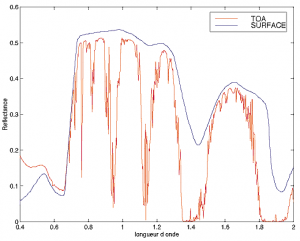![]() =>
=> ![]() Earth surface observations by space-borne optical instruments are disrupted by the atmosphere. Two atmospheric effects combine to alter the images :
Earth surface observations by space-borne optical instruments are disrupted by the atmosphere. Two atmospheric effects combine to alter the images :
- the light absorption by air molecules
- the light scattering by molecules and aerosols
Here are two SPOT4 (Take5) images, acquired with a time gap of 5 days above Morocco. Because of atmospheric effects, the second image has less contrast and is »hazier » than the first one.
 |
 |
|---|
Light Absorption :
The air molecules absorb the light within thin absorption bands. Within these absorption bands, the reflectance measured by the satellite is lessened, and in some cases, the light may be completely absorbed and the apparent reflectance at the top of atmosphere (TOA) is zero. (for instance, at 1.4µm, in the figure on the right. Such a property is used to detect high clouds with Sentinel-2 or Landsat-8).
Thankfully, the satellite designers usually choose to locate the spectral bands away from strong absorption bands (but beware of satellite designers ;-)). Within the satellite channels, the absorption is generally sufficiently low so that an approximate knowledge of the absorbent abundance is enough to obtain an accurate correction of absorption. Information on absorbing gases (ozone, water vapour) concentration may be found in weather analyses.
Light scattering
The air molecules scatter the light. A photon that passes close to a molecule will be deflected in another direction. As the air molecules are very small compared to visible light wavelengths, they will mainly scatter short wavelengths (in the blue range). The blue sky results from the scattering of sun light by air molecules, since the blue light in the sun spectrum is much scattered while the other wavelengths are mainly transmitted to the ground. A cloud also scatters the light, but its large particles (droplets, crystals) scatter all wavelengths, which explain its white colour.
Apart from clouds and air molecules, scattering may be due to aerosols. Aerosols are particles of diverse nature (sulphates, soot, dust…), suspended in the atmosphere. Their abundance, type and size are extremely variable, and their effect on light is also variable. Small aerosols will mostly scatter blue light, while larger aerosols will scatter all wavelengths. Some aerosols may also absorb light. All this variability makes the correction of their effect very tricky.
http://www.youtube.com/watch?v=oRsY_UviBPEThe above video, provided by NASA, gives an idea of the way aerosol properties may change from one day to the other, within a two years period. The colour gives an idea of aerosol types, while the colour intensity provides the aerosol optical thickness.
Simplified model :
In a very simplified way, atmospheric effects may be modelled as follows :
ρTOA= Tg (ρatm +Td ρsurf)
where :
- ρTOA is the Top of Atmosphere reflectance
- ρsurf is the earth surface reflectance
- ρatm is the atmospheric reflectance
- Tg is the air molecules (gazeous) transmission (Tg<1)
- Td is the transmission due to scattering (Td<1)
When aerosol quantity increases, ρatm increases while Td decreases. These two variables also depend on view and sun angles. The closer to vertical, the lower value of ρatm and the higher value of Td .
Adjacency effects :
The above model should only be applied to a uniform landscape. But above a standard landscape, a heavy loaded atmosphere will also blur the images. This is explained in another post.
Models, corrections.
Several models may be used to perform atmospheric corrections. For, approximate corrections, the SMAC model should be one of the simplest. SMAC be downloaded from the CESBIO site. The difficulty in using any atmospheric correction model lies in providing the necessary information on aerosol properties. We will talk about that in another post.
Other more accurate models may be used. In our case, in the MACCS processor, we pre-compute « Look-up Tables » using an accurate radiative transfer code (Successive Orders of Scattering), that simulates the light propagation through the atmosphere. But the use of a complex model is only justified if it is possible to obtain an accurate knowledge of the aerosol optical properties.

